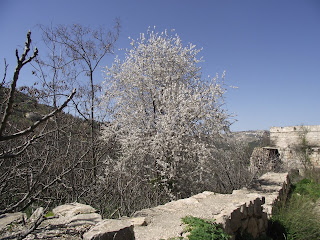By Vardah Littmann
Lifta is located in a valley at the entrance to Jerusalem
 Mention is made of Lifta by travelers who arrived in ancient
Mention is made of Lifta by travelers who arrived in ancient
Lifta, then known as Nephtho, was inhabited during the Roman and Byzantines periods. The Crusaders called it Clepsta. But since this village was four or five kilometers distant from Jerusalem , it was too far away to be an actual part of the Holy City
Lifta was one in a chain of Arab satellites-settlements around Jerusalem--; Colonia, Shech Bader, Romimah, Dir Yasin, Bet Yixsa, Bet Channinah-- that supplied the City with produce. At first they sold their wares to the inhabitants of the Old City , and then after 1865, (as the Yishuv expanded beyond the walls) they sold to the dwellers of the New City
 The Arabs of Lifta owned a lot of property. For instance, from the area that is now Romema until Kiryat Belz belonged to them. Also the
The Arabs of Lifta owned a lot of property. For instance, from the area that is now Romema until Kiryat Belz belonged to them. Also the
In 1929 the Arabs of Lifta took part in the Arab riots, harming and killing Jews. The same happened in 1936. When the Jewish underground was formed, they came to Lifta to teach the residents not to start up with Jews by beating a few of them.
On November 29, 1947, the United Nations voted in favor of the Partition Plan for what was then known as Palestine Jerusalem
From December 1st, ambushes by Arabs became more and more frequent, as well as more sophisticated. The Arab gas station owner, who was a resident of Lifta, would inform the surrounding Arab snipers when Jewish convoys were bringing supplies to Jerusalem
At the beginning of 1948, women and children left Lifta and only the Arab men remained. They would attack busses coming from the city center to Givat Shaul. Eventually the men also fled. The Haganah then blew off many of the roofs of the houses to make sure they would not return to Lifta.
In 1949 waves of immigrants reached the new State, and Yemenites were settled in Lifta. They founded three different Yemenite shuls in the area since they had different minhagim, depending on where they came from in Yemen
Today, there seems to be a lot of building going on in Lifta. Some of it is to facilitate the “high-speed train” that will take half an hour to reach Tel Aviv, running from the Binyei HaOmah building through Ben Gurion Airport
The building of a planned luxury housing complex at Lifta was temporarily halted in March 2011. There are about fifty-five, old stone buildings in Lifta. A year and a half was spent just laying foundations in order to safeguard and preserve them. The housing complex, if built, will surround the preserved Lifta spring and pool, and the old housing will be blended in with the new.
 It is also said that an anti-atomic-bomb-shelter is being built in Lifta. There will be easy access to it from the Knesset.
It is also said that an anti-atomic-bomb-shelter is being built in Lifta. There will be easy access to it from the Knesset.
Lifta is a historical corner that until today shows us the way the Bnei Yisrael farmed from the time they entered the land with Yehoshua. There is a spring whose water is gathered in a pool from which channels are directed to each section of the fields.
Lifta can be explored from different directions. You can start in Gan HaKipod (Ramot Bet) and walk to the spring. Alternately, you can descend the slope at the entrance of Jerusalem
Do not forget to bring lots of water and a hat, and do wear good comfortable walking shoes
Published in the English Update 18 August 2011




i am surprised you would show this, as this village is a major point of contention on the left, and international groups, trying to get the arabs their intact properties back.....
ReplyDeleteDear Anonymous
ReplyDeleteThe Arabs left of their own free will. But if you feel I should edit it more please let me know